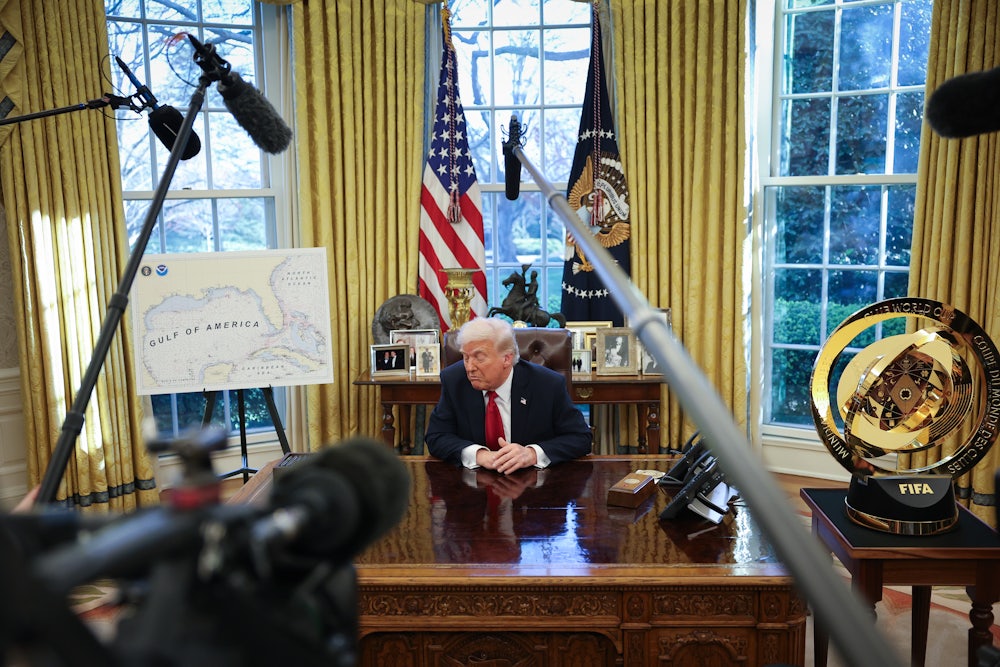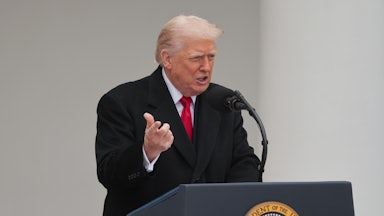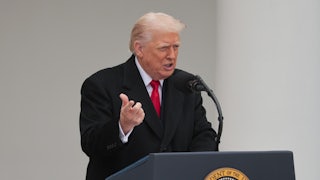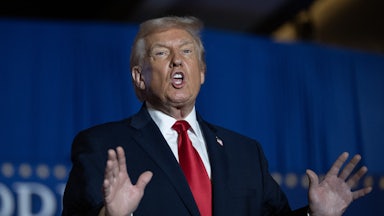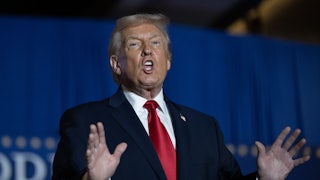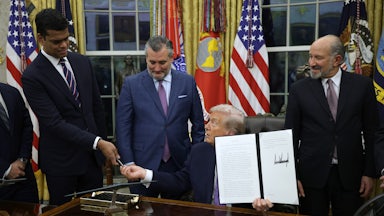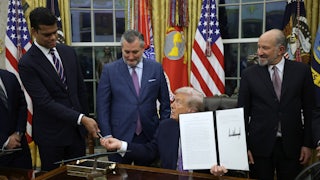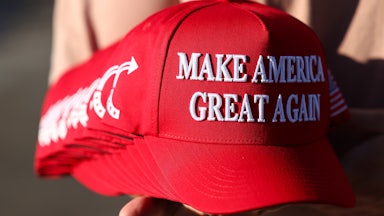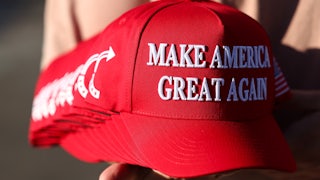I’m starting to believe April 2 really will be Liberation Day. But instead of liberating us from foreign imports, it will liberate us from any lingering illusion that Trump’s tariffs are about anything more than eliminating the progressive income tax.
If you’ve read anything I’ve written about this topic, you know the pattern. News accounts about President Donald Trump’s tariffs routinely mention that raising revenue is one of Trump’s stated goals. But they hurry quickly past this because it’s totally idiotic to think tariffs could ever replace the income tax, even partially, as a meaningful source of federal revenue. And they’re right: This idea is really, really stupid! Where the press goes wrong is in not plumbing the depths of Trump’s commitment to this stupid idea.
How stupid? Well, the IRS last year collected $2.96 trillion from income taxes on individual and corporate income, and the United States imported $3.3 trillion in foreign goods. You’ll note these numbers are pretty close. To replace all income tax revenue, you’d have to impose a tariff of nearly 100 percent on all foreign imports. Not gonna happen!
Peter Navarro, the most crazily pro-tariff person in the Trump White House, estimates that Trump will raise $600 billion annually in tariff revenue, a number that set the conservative Wall Street Journal editorial page’s hair on fire (“Democrats, who love tax increases, haven’t dared pass such a large revenue heist”). The $600 billion estimate makes economic experts across the ideological spectrum think Navarro belongs in Saint Elizabeths. But it would represent only 20 percent of all income tax revenue. Tariffs can never, ever become a major revenue source, OK? Class dismissed.
The previous two paragraphs explain why news accounts never dwell on revenue raising as Trump’s motive to impose tariffs. Too stupid! But when was anything too stupid for our commander in chief to believe? The press corps can’t accept that Trump has stupid motives because it’s too invested in the “coherence fallacy,” a term I borrow from theology. In politics, the coherence fallacy is the presumption that everything an officeholder does follows some shrewd but unspoken calculation of self-interest. It’s the reporter’s task to suss out what that calculation is.
This presumption of canniness is fallacious even when applied to highly competent politicians, who are coherent perhaps 70 percent of the time. So you can imagine how wide of the mark it falls with Trump, who—impaired already by malignant narcissism and functional illiteracy—demonstrates on a near-daily basis growing signs of cognitive decline (the latest example being his petulant response last weekend to whether the tariffs would raise auto prices: “I couldn’t care less”). If Trump were your elderly grandpa, you’d have taken the car keys from him months ago and would be starting to investigate assisted living.
Rather than face the too-obvious reality that Trump doesn’t think clearly, the financial and political press work round the clock to attach to Trump’s tariff binge some credible motive, aided in many cases by administration aides struggling to make Trump’s economic policies more appealing to the financial markets. None of these justifications quite work, and many of them conflict with one another, so they’re changing all the time. One minute we hear (from the Financial Times’ Rana Foroohar) that the skeleton key is the Miran report, a November paper about devaluing U.S. currency by Stephen Miran, chair of Trump’s Council of Economic Advisers. The next minute we hear (from Jonathan Cable and Leika Kihara of Reuters) that it’s all about factory output. Au contraire, says Reuters; it’s about killing off the World Trade Organization. Try to keep up, will you?
These journalists are all highly intelligent, ordinarily a good thing but here an obstacle to understanding. Being somewhat less intelligent, I find myself less beholden to the coherence fallacy and therefore more able to take Trump at his word when he says that “tariff” is “the most beautiful word in the dictionary.” In a meeting with Republican congressional leaders in June 2024, Trump said he favored an “all tariff policy” that would allow the United States to abandon the income tax. He said it again in October 2024, first to a bunch of guys in a Bronx barbershop (“When we were a smart country, in the 1890s … [we] had all tariffs. We didn’t have an income tax”), and then to Joe Rogan. (Rogan: “Were you serious about that?” Trump: “Yeah, sure, why not?”) Trump said it yet again in his inauguration speech (“Instead of taxing our citizens to enrich other countries, we will tariff and tax foreign countries to enrich our citizens”). One month later, Trump’s tariff-crazed commerce secretary, Howard Lutnick, discussed the idea in some detail:
His goal is to have external revenue. You know, the way I think about it, we all are so used to paying taxes, we’re so used to it, we have like Stockholm syndrome. You know, “Don’t stop the Internal Revenue Service, God forbid!” … Let [other nations] pay a membership fee. We all understand that model. Let them pay.… I know his goal is: No tax for anybody who makes less than $150,000 a year. That’s his goal. That’s what I’m working for.
This drew a little more attention than Trump’s remarks. Maybe that was because Lutnick’s scheme was one-quarter less insane. In Lutnick’s formulation, the IRS would still tax people whose income exceeded $150,000. Still, exempting everybody else would cut loose at least three-quarters of all current taxpayers, at a cost to the Treasury of about $1 trillion per year. (The under-$150,000 cohort would still have to pay payroll tax, which for most in this group exceeds what they pay in income tax. But I digress.)
A $1 trillion hole in tax receipts is smaller than the nearly $3 trillion hole left by eliminating the income tax entirely. But $1 trillion is still an insane amount to have to raise in tariffs on $3.3 trillion of imports. Lutnick said later that none of this would happen until the budget was balanced, at which time everybody heaved a sigh of relief because there’s no chance in hell Trump will ever balance the budget. Trump’s immediate reason to hunt tariff revenue is to try to cover the cost of his tax proposals: Extend the 2017 tax cut, restore the deduction for state and local taxes, eliminate taxes on Social Security benefits, et cetera. The cost of these approaches a whole ’nuther $1 trillion per year.
Have you noticed that Trump never gets a number right? He will never acknowledge arithmetic. I don’t feel certain Trump’s even signed on to Lutnick’s compromise idea of eliminating the income tax only on incomes below $150,000. But to pursue any version of this scheme, Trump needs to slap tariffs on everything that moves, while leaving his underlings to supply a rationale. Just about any justification will do.
Shut off the more intelligent part of your brain, and this is easier to grasp. In January I pronounced Trump’s 10–20 percent tariff on all foreign goods dead because I’d fallen prey temporarily to the coherence fallacy. It can happen to the best of us! Trump did back down on universal tariffs for a while, making my more uselessly intelligent self look prescient for a time. But now “Liberation Day” is here and universal tariffs may be back. The appeal of an everything tariff is that you don’t have to concoct even a phony justification.
People puzzle over why Trump singles out Canada and Mexico for tariff abuse. Puzzle no more: They’re our two biggest trading partners. Higher import volume, more tariff revenue. It’s just dumb luck that China, our third-biggest trading partner, gives us legitimate reasons to impose tariffs. If it didn’t, Trump would still be targeting it—again, for the revenue.
When Trump unveils his Liberation Day tariff package April 2, we’ll hear all sorts of sophisticated rationales from administration officials and the press. Don’t listen to them! Listen to Grandpa. Odds are he’ll brag about how much revenue they’ll raise. He won’t make any sense at all. Pay attention.
